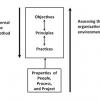|
Agile or Not: How to Get Things Done Agile software development always felt intuitive to me. Developing software incrementally, in close collaboration with the customer is the obvious way to deal with the uncertainty inherent in both software requirements and implementation. The technical practices of automating necessary but time consuming tests, and deploying, early and often are the obvious ways to give an team the ability to evaluate the functionality you have and to to decide if the software works as expected. And it's also important to decide if what you built still makes sense given the current environment. |
||
 |
Getting to "Done" in Agile Development When the tasks in the "Done" column needed more attention, the team created a "Done Done" column. Later, they created a "Done Done Done" column. In this article, Brian Bozzuto discusses how you can stop adding columns and honestly get to "done" without having to kid yourself. |
|
|
More on Being Done Continuing the conversation from last week, Andy Singleton followed up on my post on being done with this post. Which is good as this is one of those questions that sounds simple in theory, but in practice contains some subtlety. |
||
|
What Does "Being Done" Really Mean in Software Development? Agile New England (which used to be called the New England Agile Bazaar, and which was started by Ken Schwaber) , has this wonderful activity before the main event each month: they host Agile 101 sessions, where people who know something about agile lead a short (30 minutes) small (about 10 people) class on agile basics for those who want to learn more about some aspect of agile. |
||
|
The Agile Success Factor: Continuous Integration Kirk Knoernschild discusses the subtle though significant ways that continuous integration can be leveraged—from helping to align IT with the business to enforcing architectural constraints—and shows that this fundamental aspect of agility is the defining and necessary element of a truly agile development experience. |
Kirk Knoernschild
October 11, 2011 |
|
|
One-Minute Management and Project Teams Managing expectations and providing useful feedback are incredibly important skills for managers, whether you’re dealing with one employee or many. In this article, Laura Brandenburg takes a closer look at how some of the principles from the book The One Minute Manager apply to project teams. |
||
 |
Assessing an Organization’s Capability to Effectively Implement Its Selected Agile Method Shvetha Soundararajan and Dr. James D. Arthur write that the agile philosophy provides an organization or a team with the flexibility to adopt a selected subset of principles and practices. However, more often than not, these customized approaches fail to reflect the agile principles associated with the practices. |
|
|
Innovate Successfully by Creating a Lean, Minimal Product Investing in a new product always involves risk. We may have targeted the wrong market segment, envisioned the wrong product or the wrong features, or the market may have changed by the time the product is launched. |
Roman Pichler
October 7, 2011 |
|
|
A Productivity Comparison of Kanban and Scrum Charles Suscheck compares the levels of productivity of Scrum and Kanban through a hands-on experiment that he and his team personally participated in. Learn the upsides and warnings about each practice to help you decide what might work best for you and your team on your next project. |
||
|
How to Manage the Hurly-Burly Hubbub of Change Giving yourself, and your team, the necessary time to adapt to and move on from change is the healthiest way to make sure that everyone is back on the same page in a timely manner. Learn how to avoid prolonging the necessary time to "heal" by minimizing turbulence. |
Pages
Upcoming Events
| Jun 02 |
AI Con USA Bridging Minds and Machines |
| Sep 22 |
STARWEST Software Testing Conference in Anaheim & Online |
| Oct 13 |
Agile + DevOps USA The Conference for Agile and DevOps Professionals |
Recommended Web Seminars
| May 23 | How Generative AI Boosts Speed and Quality in Software Testing |
| On Demand | Building Confidence in Your Automation |
| On Demand | Leveraging Open Source Tools for DevSecOps |
| On Demand | Five Reasons Why Agile Isn't Working |
| On Demand | Building a Stellar Team |








